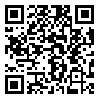Volume 14, Issue 5 (Dec & Jan 2021)
payavard 2021, 14(5): 454-464 |
Back to browse issues page
Ethics code: IR.TUMS.SPH.REC.1398.262
Download citation:
BibTeX | RIS | EndNote | Medlars | ProCite | Reference Manager | RefWorks
Send citation to:



BibTeX | RIS | EndNote | Medlars | ProCite | Reference Manager | RefWorks
Send citation to:
Dehghanisanij S, Mostafavi I, Zarghami H, Soleimani H. Measuring the Interactions of University, Industry and Government of Iran in Scientific Articles of Biomedical Engineering Field Using the Triple Helix Model. payavard 2021; 14 (5) :454-464
URL: http://payavard.tums.ac.ir/article-1-7000-en.html
URL: http://payavard.tums.ac.ir/article-1-7000-en.html
1- Master of Science in Medical Library and Information Sciences, School of Allied Medical Sciences, Tehran University of Medical Sciences, Tehran, Iran
2- Assistant Professor, Department of Knowledge and Information Science, Faculty of Social Sciences, Yazd University, Yazd, Iran
3- Assistant Professor, Department of AMAD, Graduate Center, Shahid Sattari Aeronautical University of Science and Technology, Tehran, Iran
4- Lecturer, Department of Medical Library and Information Sciences, School of Allied Medical Sciences, Tehran University of Medical Sciences, Tehran, Iran ,daneshshenas@gmail.com
2- Assistant Professor, Department of Knowledge and Information Science, Faculty of Social Sciences, Yazd University, Yazd, Iran
3- Assistant Professor, Department of AMAD, Graduate Center, Shahid Sattari Aeronautical University of Science and Technology, Tehran, Iran
4- Lecturer, Department of Medical Library and Information Sciences, School of Allied Medical Sciences, Tehran University of Medical Sciences, Tehran, Iran ,
Abstract: (2032 Views)
Background and Aim: The field of medical engineering is the flagship interdisciplinary approach in Iran, which, due to its attention to knowledge-based economy, takes a step towards prosperity and smoothing progress and development. The purpose of this study is to investigate the interactions between university, industry and government of Iran in scientific articles in the field of medical engineering using the triple helix model.
Materials and Methods: This is an applied research with a quantitative approach and uses scientometric techniques. The status of dynamic interactions of the main pillars of Iranian innovation in the field of medical engineering in WoS (Web of Science) database has been calculated using the .exe and the 4.exe softwares in the period of 2010-2019, and the transmission degree of uncertainty index in dual and national dimensions has been determined.
Results: The T-index ranking was assigned to university-government(23.38 mb), university-industry(8.47 mb) and industry-government (1.13 mb), respectively, and finally, national interaction(-12.48 mb) was obtained. The interaction between university and industry had an increasing trend and the strongest dual interaction belonged to the university-government. Over the last ten years, national interaction has always had a negative value, which indicates the existence of dynamics in interactions in the national dimension.
Conclusion: The dual university-industry interaction has been increasing in recent years; however, in the long run, the national interaction of the pillars has been facing a declining trend, according to which some science and technology policies, and research and industrial strategies have been proposed as a necessity to promote the university-industry-government innovation network in the field of medical engineering in Iran.
Materials and Methods: This is an applied research with a quantitative approach and uses scientometric techniques. The status of dynamic interactions of the main pillars of Iranian innovation in the field of medical engineering in WoS (Web of Science) database has been calculated using the .exe and the 4.exe softwares in the period of 2010-2019, and the transmission degree of uncertainty index in dual and national dimensions has been determined.
Results: The T-index ranking was assigned to university-government(23.38 mb), university-industry(8.47 mb) and industry-government (1.13 mb), respectively, and finally, national interaction(-12.48 mb) was obtained. The interaction between university and industry had an increasing trend and the strongest dual interaction belonged to the university-government. Over the last ten years, national interaction has always had a negative value, which indicates the existence of dynamics in interactions in the national dimension.
Conclusion: The dual university-industry interaction has been increasing in recent years; however, in the long run, the national interaction of the pillars has been facing a declining trend, according to which some science and technology policies, and research and industrial strategies have been proposed as a necessity to promote the university-industry-government innovation network in the field of medical engineering in Iran.
Keywords: Triple Helix Model of Innovation, University, Industry, Government, Biomedical Engineering, Knowledge Economy, Iran
Type of Study: Original Research |
Subject:
Medical Library & Information Sciences
ePublished: 1399/07/23
ePublished: 1399/07/23
Send email to the article author
| Rights and permissions | |
 |
This work is licensed under a Creative Commons Attribution-NonCommercial 4.0 International License. |





